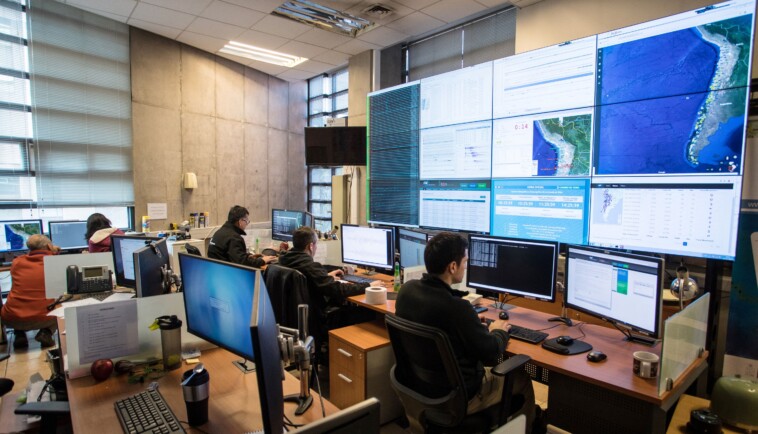When a 4.4-magnitude earthquake rattled Los Angeles on Aug.13, it didn’t come as a complete surprise to everybody. About a million Californians got an early alert on their phones that a quake was imminent.
How did it happen? It was thanks to the newly-developed MyShake app, created by researchers at the University of Berkeley, in partnership with the California Governor’s Office of Emergency Services. The app basically works as a crowdsourced detector, collecting motion data from phones across the West Coast — from California up to Washington State — and sends out alerts based on a phone’s location.
It’s not a lot of advance notice. “The amount of warning varies from a few seconds to tens of seconds depending on the location of the quake and the availability of phones,” says Richard Allen, Ph.D, the director of the University of California Berkley’s Seismology Lab, who helped develop the tech.
It might seem like nothing — how much difference can a few seconds really make — but in the field of earthquake forecasting, it might as well be the invention of the telephone. For years, the idea of being able to predict an earthquake wasn’t just unlikely. As seismologist Allie Hutchison wrote for the MIT Technology Review, the very idea of it was deemed unserious as recently as 2013, “as outside the realm of mainstream research as the hunt for the Loch Ness Monster.”
Many prominent scientists still feel that way. “I’ve studied earthquakes for more than 50 years and I have seen many studies from scientists who reported precursory phenomena to significant earthquakes,” says Tom Heaton, a geophysicist at Caltech. “In my experience, no one has developed a system to predict earthquakes. I strongly believe that this is a problem in self-organizing chaos. This is an important field of physics that is mostly unfamiliar to earth scientists.”
Historically, the science of earthquake predictions has been a mixed bag of voodoo and quackery. From misguided theories about “earthquake weather” to the 1990 prediction that inspired a “War of the Worlds”-style panic (including building bunkers) to Japanese seismologists who suggested in a 1933 study that catfish could predict earthquakes with 80% accuracy, there hasn’t been much to inspire optimism.
Even Japan, with one of the most active earthquake hot spots in the world, is cautious about overpromising. When a 7.1-magnitude earthquake hit the country’s southern islands earlier this month, Japan Meteorological Agency issued its first ever “megaquake advisory,” warning of a “higher than normal” chance of a second, stronger quake. But the agency clarified on their website that the warning doesn’t mean certitude. “Information that predicts earthquakes by specifying the date, time and location is a hoax,” the statement read.
But that opinion is slowly starting to change as the science evolves. “There has been a debate for many years in the seismology community on whether earthquakes are a chaotic phenomenon or a deterministic one,” says Quentin Bletery, an earth science researcher at Côte d’Azur University in Nice, France. “If earthquakes are a chaotic phenomenon, no matter the technology we will never be able to predict them.”
But if earthquakes are deterministic — meaning, there are precursor anomalies that can be observed in advance with the right instruments — “then earthquake prediction will become possible,” Bletery says.
Seismologists are attempting to do just that with machine learning, looking for hidden patterns and data in ways that have never before been attempted.
“Most previous attempts focused on the very complex physics of earthquakes,” says Sergey Fomel, a geoscientist at University of Texas at Austin who led a seven-month earthquake forecasting trial in China last year. “In our approach, physics is combined with statistical data analysis using the new tools of machine learning and artificial intelligence. We extract physical attributes from the recorded data to combine them statistically for the best prediction.”
The results, which were published in the Bulletin of the Seismological Society of America last September, exceeded their expectations. Their AI algorithm, trained to detect statistical bumps in real-time seismic data, correctly predicted 70% of earthquakes (fourteen in all) at least a week in advance and within 200 miles of their epicenters. (The algorithm missed one quake, and predicted eight that never took place.)
“The success rate in the China experiment was astounding,” Fomel tells The Post. “Given the complexity of the problem and the long history of previous failures, nobody expected such a result.”
This data-driven approach to earthquake forecasting may very well be the future of seismology, and scientists are exploring all the possible ways that machine-learning can get us closer to full-on predictions. At the Universities of California at Berkeley and Santa Cruz, researchers are developing a new model, dubbed RECAST— short for “Recurrent Earthquake foreCAST” — that provides deep learning for earthquake forecasting.
It works similarly to a language model, which “uses a ton of written text to create a best guess of what the next word might be,” Kelian Dascher-Cousineau, a UC Berkeley researcher who led the study, tells The Post. “RECAST uses large catalogs of earthquakes to create a best guess at the timing of the next earthquake.”
Bletery has focused his research on the subtle signals that occur before many major earthquakes, barely perceptible movements known as “aseismic slips” that don’t produce seismic waves but can be detected with GPS sensors.
Although this phenomenon has been studied in the past, Bletery and his team attempted to analyze all the global data rather than just one particular event.
“What we did was essentially summing up all the GPS observations recorded before earthquakes that were magnitude 7.0 or greater,” he tells The Post.
What they discovered is that two hours before a quake, there was an exponential acceleration in the horizontal movement of the sensors. An exciting discovery, but it doesn’t mean we’ll be able to predict the next devastating earthquake. Identifying aseismic slips as a real phenomenon is only half the battle. The other half is creating tools to spot them.
“This will require developing sensors capable of recording the ground motion at least 100 times more precisely than our current geodetic instrumentation, which is a huge technological challenge,” says Bletery. If that happens, however, “we may hope to predict earthquakes.”
We’re closer than ever before to having earthquake alerts that are more than just an alert on your phone, giving you a few-second warning to seek shelter. But the science — or at least the new data-driven, machine-learning approach to seismology — is still in its infancy. “We still have more questions than answers,” warns Heaton.
Dr. Robert Geller, a professor emeritus in seismology at the University of Tokyo, has long been a vocal critic of earthquake predictions, even as a hypothetical idea.
“Carl Sagan famously said ‘extraordinary claims require extraordinary proof,’” he tells The Post. “In other words, in view of the thousands of prediction claims that have ultimately been rejected for the past 140 years, unless these folks have really strong data, they’ll have a hard time getting traction.”
But “really strong data” is exactly what many researchers have been gathering in recent years. Yangkang Chen, Ph.D., a lead developer in the University of Texas AI study last summer, says they plan on testing their methods in seismically active areas other than western China, including the West Coast of the US, Japan, and the Mediterranean area.
“We need to verify that the same forecasting framework is generalizable,” Chen says. “As soon as we can clone the same success of earthquake forecasting in many areas, we’ll focus on improving the prediction performance by adjusting the AI model and collaboration with top-notch data scientists.”
There’s reason for optimism, Chen says, because artificial intelligence is completely data-driven and physics-free. “It’s not biased towards any human-defined assumptions,” she says. “As long as it can reach a statistically convincing score, it shows something, regardless of whether you acknowledge the anomaly is a precursor signal or not.”
At least for now, the data are just that — data. The data sets “have the potential to be hugely informative,” says Dascher-Cousineau. “But they also come with their own sets of quirks.” The challenge for today’s seismologists is determining what to do with all that data, so that tomorrow’s earthquake predictions aren’t just best guesses.
“Even if you think you have a better model, this might not be clear right away,” says Dascher-Cousineau. “Imagine trying to settle a debate about whether a coin is biased after only seeing a couple of flips of the coin.”











